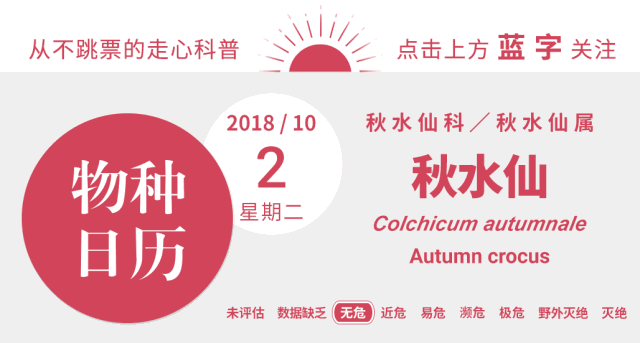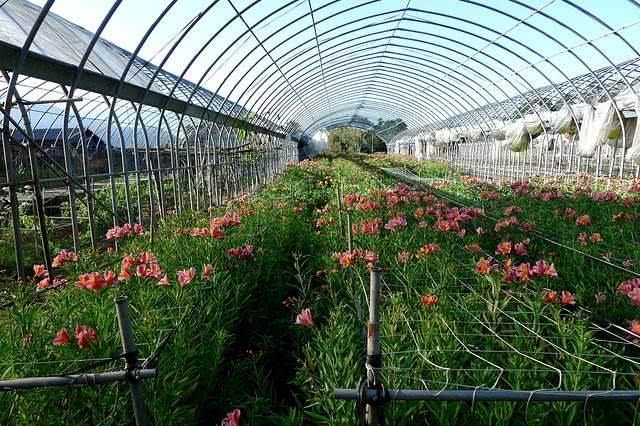Why can highly poisonous autumn daffodils relieve gout?

When the seven-day holiday comes, most people are happy, but there are also many unhappy people, such as gout patients, who suffer from both physical and mental torture in the face of good wine and food. The most commonly used drug for gout is colchicine, which was first extracted from colchicine Colchicum autumnale, as can be guessed from its name.
C. autumnale. Photo: M. Martin Vicente / flickr
Autumn daffodils with personality
In the old classification system, autumn daffodils were a genus of the Liliaceae. At that time, the Liliaceae was like a big basket with everything in it. Later botanists realized that the species in the old Liliaceae should belong to many different groups, so they dismantled the Liliaceae. Now, the genus Colchicus, with more than 20 brothers, has established a family Colchicaceae. Most of the plants in this family are the same as colchicines, beautiful in appearance but highly poisonous.
The gorgeous autumn daffodil C. speciosum, with six perianth and six stamens, is no wonder it was classified as Liliaceae in the old classification system. Picture: Yu Tianyi
The flowers and leaves of autumn daffodils are different at the same time, in fact, there are many plants with similar habits, such as Yingchun, Lycoris, paulownia, but not so many as daffodils. Autumn daffodil in English has an individual named naked ladies, literal translation is naked woman, describes its flowers, when blooming, there are really only flowers on the ground, not only no stem, no leaves, not even inflorescence axis.
Wild autumn daffodils on the slopes of Leyson, Switzerland. Picture: desert porcupine
Blossom before the roots grow.
The autumn daffodil is native to the grasslands of low and middle elevations in Europe. the underground part is an oval bulb of different sizes, the wild one is one circle smaller than the egg, the horticultural one can be bigger than the adult fist, the bulb itself is white, and there is a layer of brown dry skin outside.
Horticultural bulbs of autumn daffodils at the flower show. Picture: Yu Tianyi
When dormant in summer, peel off the skin of the autumn daffodil bulb and you can see a small bud, which is not only the flower of this autumn, but also the new bulb of the next spring.
Peel off the skin of the bulb. Picture: desert porcupine
Every autumn, colder and colder temperatures and shrinking sun notes break the dormancy of the daffodils, and the nutrients accumulated in the old bulbs are constantly transported to the new buds, which will soon sprout and produce pink-purple flowers. it stands out in the surrounding green grass.
C. × agrippinum in full bloom does not grow leaves when it blossoms. Picture: Yu Tianyi
The flowers of autumn daffodils grow not only earlier than the leaves, but also earlier than the roots. Almost all the nutrients and water consumed at the beginning of flowering come from the bulbs, which do not need roots to provide, and the roots will grow back later.
Real daffodils can be cultivated soilless and soaked in water. Autumn daffodils don't even need water. You can see flowers anywhere you buy them. Of course, you still have to plant them in time after flowering, otherwise you won't be able to see them next year. At present, autumn daffodils are still a kind of high-priced flowers. If you throw them away in one crop, it will do a lot of harm to your wallet.
It can blossom even if you leave it like this. Picture: bakker.com
The fruit and leaves drilled out of the ground together
The blooming period of the autumn daffodils is very long, which can last for more than a month. After the flowering period, the leaves will drill out of the surface and look fat and tender, but they can't be eaten. The ovary of the autumn daffodil is located at the base of the underground bulb, and it is dark when it blossoms. After pollination, the ovary develops into fruit in the ground, and the leaves germinate to a certain height before they come out together.
The leaves of autumn daffodils. Picture: Dr. Nachtigaller / wiki commons
The capsule of autumn daffodils. Picture: BerndH / wiki commons
After the leaves germinate, they are energetically produced and stored through photosynthesis. at this time, the old bulbs gradually shrink, and the underground part of the new buds slowly develop into a new generation of bulbs, dormant next summer to perform the duties of their predecessors. to provide for the new buds of the next generation.
Some autumn daffodils also grow leaves when they bloom, such as this C. parlatoris. Picture: Yu Tianyi
What did colchicine do?
Colchicine is rich in colchicine, an alkaloid, also known as colchicine, which is not toxic, but will be oxidized into highly toxic colchicine oxide when eaten in the body. The mechanism of colchicine is to inhibit the polymerization of tubulin in cells, thus interfering with all life activities involved in microtubules. Microtubules are very important in cells. Once they are disturbed, the work of the cells will be disordered and people will be poisoned. In general, adults who take 6-7 mg of colchicine may die. Accidentally eating a bulb of colchicine will have to go to first aid. In fact, it is only to reduce tissue damage, because there is no specific drug for colchicine poisoning.
Now the colchicine eaten by patients with gout is not a natural product, but has modified the molecular structure and reduced toxicity, so it is not so easy to eat the dead. But why can it cure gout? This starts with the mechanism of gout.
The pain of gout is an inflammatory reaction caused by the accumulation of crystals in the joints caused by too much uric acid in the blood. This inflammatory reaction is actually neutrophils (the white blood cells in the "working cells") trying to remove uric acid.
In the human body, neutrophils account for 60% to 70% of the total number of white blood cells. Photo: "working Cell" / Shimizu / talking Society? ANIPLEX?davidproduction
The migration of neutrophils in the body depends on microtubules, and colchicine inhibits microtubule polymerization, thus blocking the mobility of neutrophils. If it can't reach the joint, it won't become inflamed. Of course, the chief culprit of uric acid crystallization is still there, but the pain is gone.
British satirical cartoonist James Gilley's "gout" is caused by diet and genetic factors. Colchicine can relieve symptoms, but patients still need to adjust their diet. Photo: James Gillray (1799) / wiki commons
Colchicine's ability to inhibit microtubules also makes it a regular in breeding experiments. High school biology textbooks have said that colchicine can induce chromosome doubling by inhibiting the formation of spindles, and it is necessary to cultivate seedless watermelons. This is because the spindle is actually made up of microtubules, so it is disturbed by colchicine. Colchicine can not only induce polyploidy, but also cause gene mutation, which is often used in mutation breeding.
The cultivation of triploid seedless watermelon, you must have seen this picture in your high school biology textbooks. Picture: slidesplayer.com
Inedible daffodils and edible...
The colchicine is all over the body of the colchicine, which must not be eaten, but its flowers and leaves are very similar to the two edible plants, and the flower shape and flowering habits are very similar to the saffron Crocus sativus of the Iridaceae. The silk of the stamens of saffron is an edible spice and dye. The most obvious difference in flower appearance between autumn daffodils and crocuses is the stamens. There are six autumn daffodils and three crocuses.
Saffron has three stamens. Picture: desert porcupine
The leaves of autumn daffodils look similar to Allium ursinum, which tastes like leeks and is a kind of wild vegetable in Europe. The leaves of bear onions are flat. When they first sprout, they look not only like autumn daffodils, but also like lilies of the valley, and lilies of the valley are also poisonous.
Bear onion. Picture: wikipedia
Therefore, when you are in the wild, you must keep your mouth shut and don't eat everything. It's not worth dying for a mouthful of food (which may not be delicious).
Finally, let's take a look at some beautiful autumn daffodils and thank Tianyi for sending Meitu from England. Remember, you can't eat these:
The variety "water lily" C. "Waterlily" of the genus Narcissus. Picture: Yu Tianyi
C. variegatum. Picture: Yu Tianyi
C. lusitanum of Spanish colchicine. Picture: Yu Tianyi
This is the 275th article in the fourth year of the species calendar, from @ Desert Porcupine, author of the species calendar.
Flowers that you might also want to know.
Calendar Niang also wants a little star!
The official account is so hot that if you are not careful, you will not find your favorite species calendar and calendar Niang, what to do?
Light up the little stars for the species calendar, of course!
If not, open the "…" at the top right of the main page of the official account. Button, select "set as a star"!
- Prev

How to grow a good flower, first of all, you must know the temperature it likes to start correctly
Each flower is an independent individual, they have their own growth preferences, such as sunlight, water, temperature, soil and other aspects of the requirements are different. Especially temperature, it is one of the most important conditions for flower growth, which is the flower growth...
- Next

Celebrate the 69th anniversary of the motherland's birthday and record my story with succulent plants.
Preface follow Encyclopedia meet beautiful (WeChat account: duoroubaike) text begins: thank the author [elegant Music Dance] for the original contribution, sharing and editing: encyclopedia coordinates: Maanshan, Anhui.
Related
- Wuhan Hospital Iron Tree Blooming Result Was Instantly Frightened by the Gardener Master
- Which variety of camellia is the most fragrant and best? Which one do you like best?
- What is the small blue coat, the breeding methods and matters needing attention of the succulent plant
- Dormancy time and maintenance management of succulent plants during dormancy
- Minas succulent how to raise, Minas succulent plant pictures
- What are the varieties of winter succulent plants
- How to raise succulent plants in twelve rolls? let's take a look at some experience of breeding twelve rolls.
- Attention should be paid to water control for succulent plants during dormant period (winter and summer)
- Watering experience of twelve rolls of succulent plants
- Techniques for fertilizing succulent plants. An article will let you know how to fertilize succulent plants.

